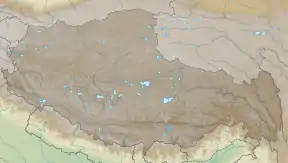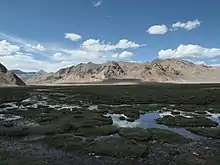Sengge Zangbo
Sengge Zangbo,[1][2] Sengge Khabab[3] (Tibetan: སེང་གེ་ཁ་འབབ།, Wylie: seng ge kha 'bab) or Shiquan He (Chinese: 獅泉河; pinyin: Shīquán Hé) is a headwater of the Indus River in the Ngari Prefecture in Tibet Autonomous Region, China. About 300 km from its sources, in the mountain springs north of the Manasarovar lake,[4] the river merges with Gar Tsangpo near the village of Tashigang to form the Indus River.[5] The Tibetans continue to regard the combined river as Sênggê Zangbo as it flows into Ladakh.
| Sengge Zangbo Sengge Khabab, Shiquan He | |
|---|---|
 Confluence of Gar Tsangpo and Sengge Zangbo | |
| Etymology | "Lion River" |
| Native name | སེང་གེ་ཁ་འབབ། (Standard Tibetan) |
| Location | |
| Country | China |
| State | Tibet Autonomous Region |
| Region | Ngari Prefecture |
| Physical characteristics | |
| Source | |
| • location | Kailas Range, Gêgyai County, Tibet, China |
| • coordinates | 31°18′44″N 81°48′42″E |
| • elevation | 5,469.8 m (17,946 ft) |
| Mouth | |
• location | Gar Valley (Indus Valley) |
• coordinates | 32.4409°N 79.7121°E |
• elevation | 4,300 metres (14,100 ft) |
| Length | 300 km (190 mi) (approx.) |
| Basin features | |
| Progression | Indus River |
The town of Shiquanhe, the administrative headquarters of the Ngari Prefecture, is located in the lower valley of Sengge Zangbo, and is named after the river.

The Sengge Zangbo drains an area of 27,450 km2, and covers a length of 430 km. Main tributaries include Gar Tsangpo. Other tributaries include Langqu River, Chizuo Tsangpo River, Charinongqu River.[6]
References
- Scientist finds new origin of Indus River, China Daily, 21 October 2010.
- Mayhew, Bradley; Kohn, Michael; Mccrohan, Daniel; Bellezza, John Vincent (2011), Tibet, Lonely Planet, p. 164, ISBN 9781741792188 – via archive.org
- Chodag, Tibet, the Land and the People (1988), p. 153.
- Sering, Senge (April 2010), "China builds dam on Indus near Ladakh" (PDF), Journal of Defence Studies, 4 (2): 136–139
- I︠U︡sov, Physical Geography of Tibet (1959), p. 80.
- Zheng, Tianliang; Deng, Yang; Lin, He; Xie, Yanhua; Pei, Xiangjun (April 2022). "Hydrogeochemical controls on As and B enrichment in the aqueous environment from the Western Tibetan Plateau: A case study from the Singe Tsangpo River Basin". Science of the Total Environment. 817: 152978. Bibcode:2022ScTEn.817o2978Z. doi:10.1016/j.scitotenv.2022.152978. ISSN 0048-9697. PMID 35016932. S2CID 245859130.
the [Singe Tsangpo River] has many tributaries originating from alpine lakes or glaciers, including the Langqu River, Chizuo Tsangpo River, Charinongqu River
Bibliography
- Chodag, Tiley (1988), Tibet, the Land and the People, translated by Bkras-gliṅ Dbaṅ-rdor (Brag-gdoṅ); W. Tailing, New World Press, ISBN 9787800050725
- I︠U︡sov, B. V. (1959), Physical Geography of Tibet, U.S. Joint Publications Research Service